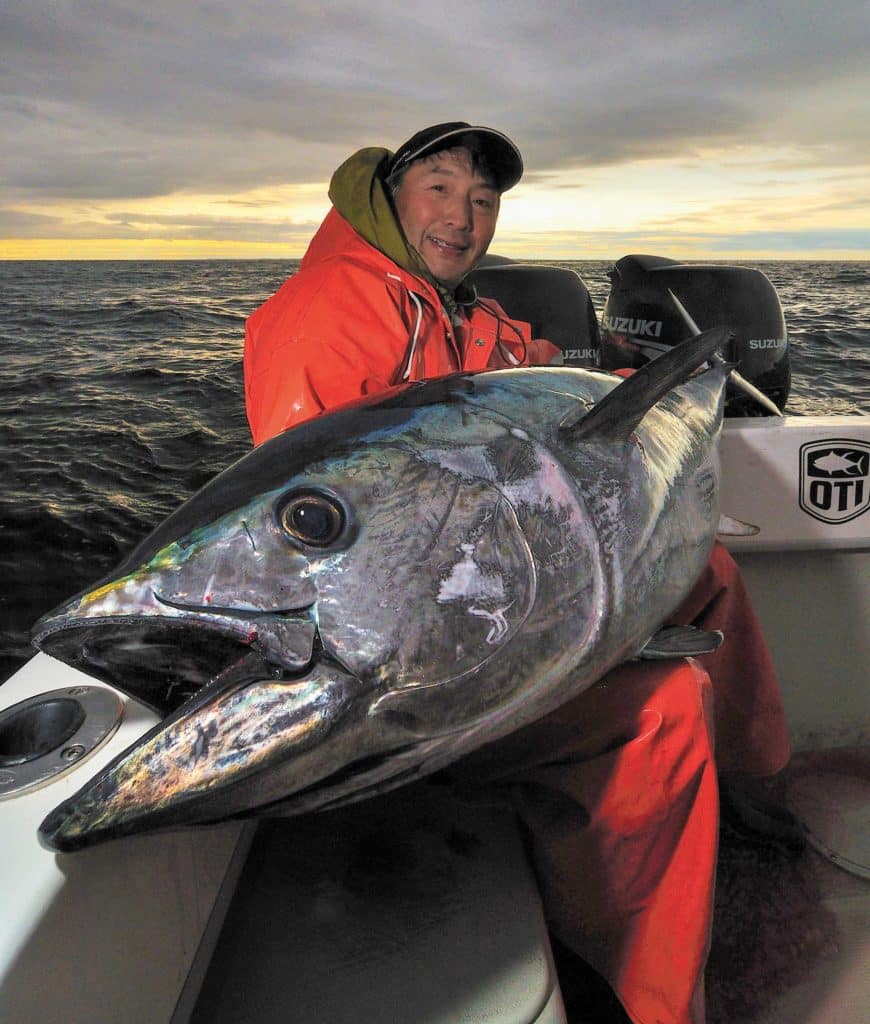
Splashing and chattering away behind Fortunate Son, Christian Driscoll’s 32-foot Regulator, an eight-rod spread of Side Tracker squid spreader bars were dutifully doing their job in the Chicken Canyon, 46 miles off the Jersey coast.
As the morning’s first sunbeams glowed over the Atlantic, three of the reels went off, sending our three-man crew into a frenzied drill to quickly get the strikers under control. Two bluefins were immediately gaffed and boxed, and the other tuna was released.
The ease of deploying Side Trackers put us immediately back in the game, and a moment later, we had on another triple. We left the dock at 5 a.m. and were back by 11 a.m., so in the six hours it would have taken to do a half-day fluke trip in the bay, we’d gone offshore, brought a pair of bluefins over the gunwale, released four others, and had numerous knockdowns.
Innovative Creation
Jason Braun of ChatterLures is the innovator behind what he calls a “multidirectional, rudder-based spreader bar,” more commonly known as a Side Tracker. “I wanted to design not just a splash bar, but one that creates great chatter and disturbance in the water, and also lets anglers fish a bunch of them at once from a small- to medium-size vessel without needing outriggers or a lot of space,” Braun says. That expanded spread is exactly what is needed to fool bluefin tuna in the midshore waters off New York, New Jersey and Maryland during the summer.
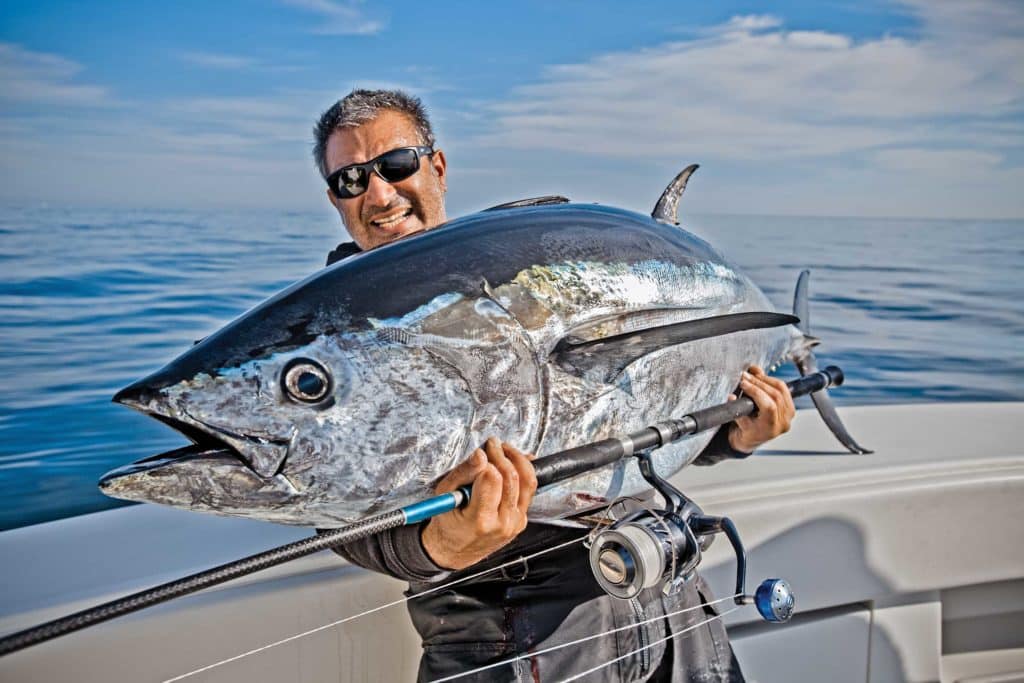
“I run a 31-foot Contender and, like other small boaters, I can’t pull a giant spread. Straight bars almost immediately clutter up, resulting in an abnormal presentation and aggravating tangles. To avoid that, we developed a rudder mechanism that allows for a wide spread of bars to be deployed without the need of outriggers or a large cockpit, and without creating a mess when the boat turns.
“The original idea was a stationary rudder, but then I thought, why limit to only one side of the boat? And we designed the Side Tracker rudder so that a simple click allows you to switch from port to starboard or vice versa in a second. That really comes in handy when tuna are on the bite, and you need to change up the spread fast.”
Setup Options
Braun runs six Side Trackers on his boat. “My spread is two 36-inchers from the bow, two 19-inch bars midship in the long riggers, and two 36-inchers back off the stern. The bow placement allows you to get in that middle water, which is so hard to do with two bars normally in the riggers.” If you do have a larger vessel equipped with outriggers, Braun recommends running the 19-inch Side Trackers off the outriggers, so you can get them way out there, and even run three lines from the riggers.
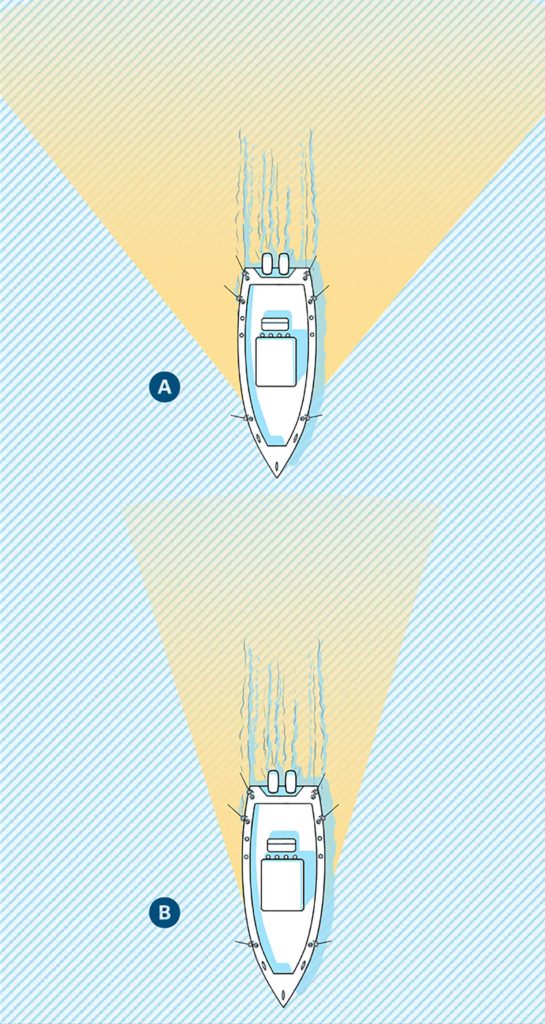
In any tuna spread, the frantic bubble wash is the key to drawing strikes. Side Trackers allow anglers to widen the coverage area outward so the spread is not so compact. In essence, they enable you to create a mini school on the offshoot outside the main school, a small compact breakout school with its own bubble trail. Additionally, trollers can now make quicker turns because, thanks to the resistance of the rudders, bars don’t slide into each other. As well, anglers starting out with a Side Tracker need to just remember a simple notion: The long end of the rudder points forward and away from the boat, in the direction you want the tracker to go.
Spread ‘Em Out
“You make a much better tuna pattern off a center-console with Side Trackers,” states Capt. Erwin Heinrich of Scales-N-Tales charters, who loves the simplicity of setting a spread without outriggers. “I fish ’em right from the gunwales on my 32 CC. I run a 10-rod spread in a diamond pattern, two off the stern, and the rest off the port and starboard sides. I set the port and starboard rods like a row of bowling pins on a slant, with four Side Trackers on each side—from the stern to the bow, starting in the prop wash, and working their way farther out. The two in the bow act as my outrigger lines.”
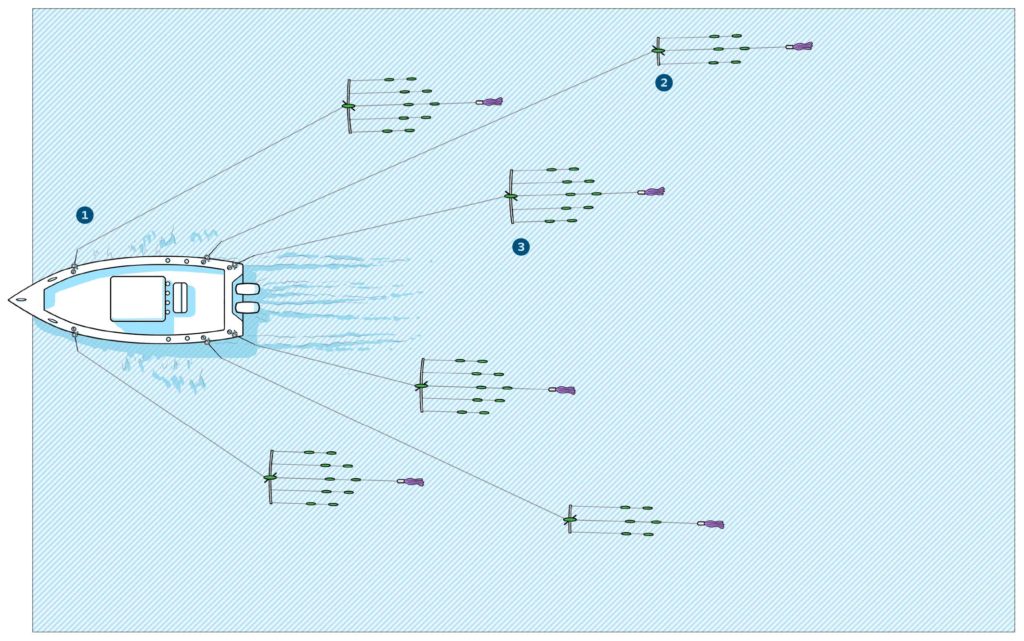
Heinrich will even set two more straight spreaders right off the rocket launchers behind the console to create an 11-rod spread. “Tuna like noise; when there’s no boat traffic, they will come in to inspect commotion close to the boat. But when there’s more traffic, you need to put the bars farther back. In glassy conditions with following seas, however, I like placing the bars on the crest of each wave.” Darker-color squid patterns such as black-and-purple are go-to colors on dark days, and pre-dawn and early-morning hours. Lighter-color patterns, like the Zucchini and Rainbow squids, work better on bright, sunny days, or after 10 a.m., whenever the sun is up.
Effective Modifications
Modifications afford definite advantages, Heinrich says. “I modify the back of the Side Tracker spreader bar, adding a long stinger hook fixed in a ballyhoo rigged on a Joe Shute, Green Machine or RonZ rubber lure. Be sure to adjust the length of the stinger hook. Normally, it’s 4 to 5 feet back, but make it longer—about 6 to 8 feet—if seas are rough. Another trick is to add egg sinkers to the squids to weigh them down and make them hold better.”
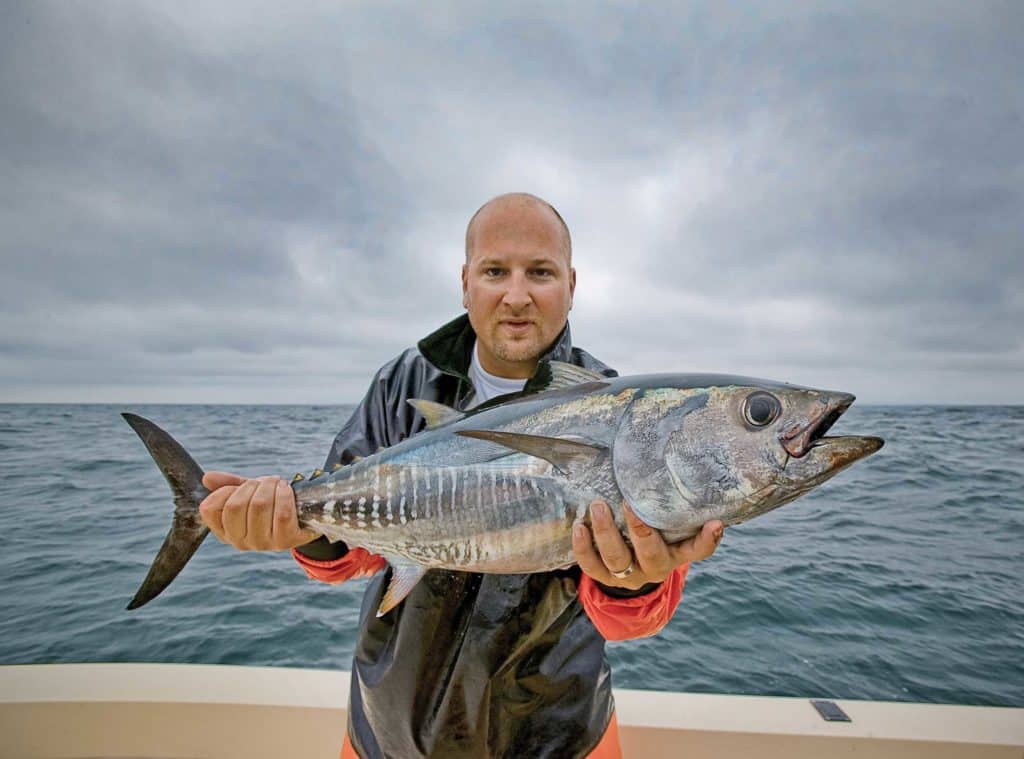
Generally, a 4- to 6-knot pace is preferred, but you should adjust according to the conditions and the bite. “For bluefins, if I’m marking fish, I’ll go into neutral to sink ’em down slowly, then come up to speed. Another trick is to make sharp S-turns so the outside bars are really splashing around to produce a reaction bite. If the tuna are picky and the bite is slow, the inside track will be a better presentation. Try different approaches to adjust to the speed tuna are focusing on.”
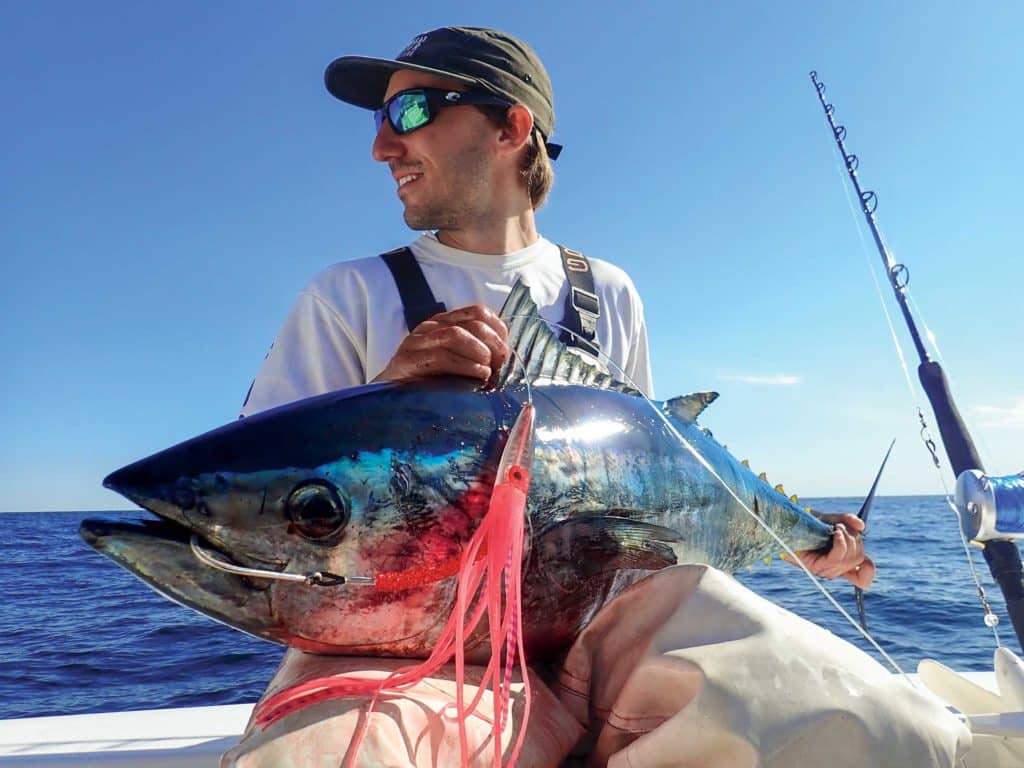
Side Tracker spreader bars even the playing field. Gone are the days of needing one of the big battlewagons to effectively troll for bluefins. Now small-boat anglers can compete with the best of them.
When
May through September
Where
Northeast and mid-Atlantic waters
Who
These seasoned captains fish with Side Tracker spreader bars and can show you how:
Capt. Freddy Gamboa, Andrea’s Toy, andreastoycharters.com, 732-672-1561
Capt. Erwin Heinrich, Scales-N-Tales, sntfishing.com, 908-477-7537
Capt. Alan Lee, Mushin Sportfishing, mushinsportfishing.com, 609-731-3742
Trolling for Bluefin Tuna
Side Tracker spreader bars are made by ChatterLures (chatterlures.com), but other companies offer similar products. The unrigged Smart Bar (tournamentcable.com) features a Premium 3-Position Side Tracker bird with an adjustable rudder. The Wide Tracker (sterlingtackle.com) and Sidewinder Tracker Bar (tormentertackle.com) incorporate a clear, fixed directional fin on the lead bird, requiring you to purchase port- and starboard-specific models.
Rods: Shimano Tallus 50- to 80-pound class, or equivalent
Reels: Shimano Tiagra 50 wide or 80, or equivalent
Line: 80-pound running line, 300- to 400-pound leader
Lures: Side Tracker spreader bars, or equivalent









